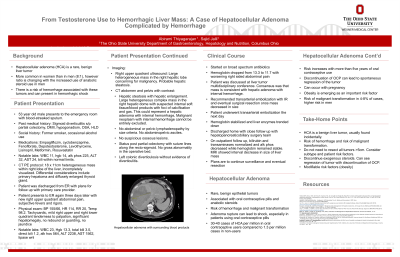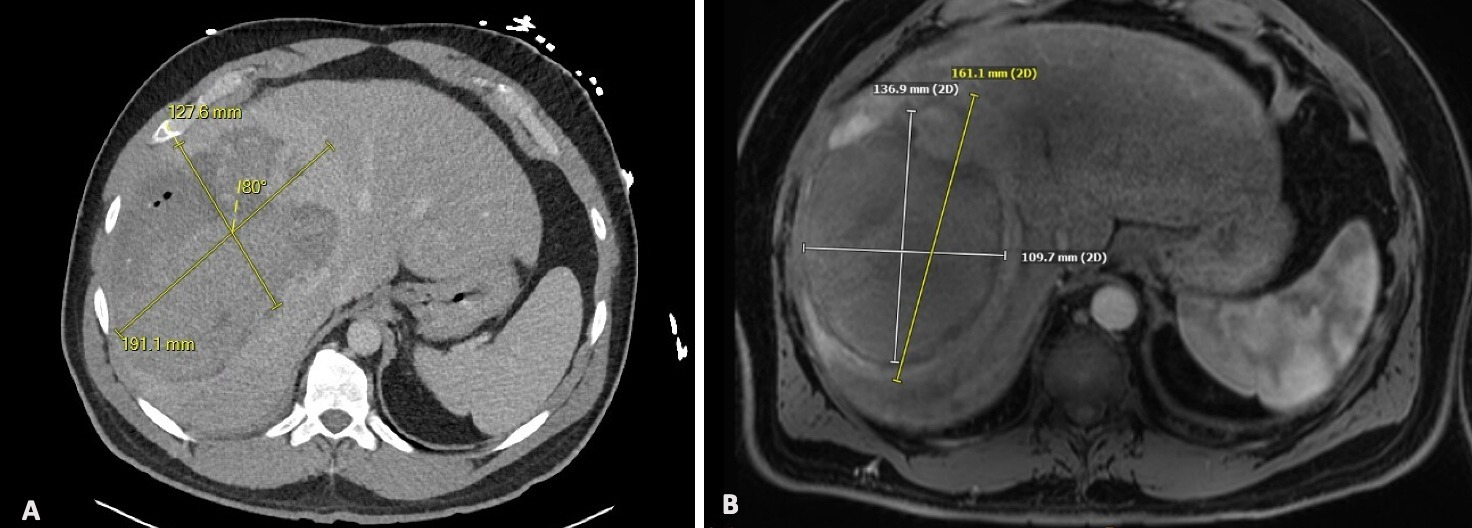Monday Poster Session
Category: Liver
P2457 - From Testosterone Use to Hemorrhagic Liver Mass: A Case of Hepatocellular Adenoma Complicated by Hemorrhage
Monday, October 23, 2023
10:30 AM - 4:15 PM PT
Location: Exhibit Hall

Has Audio
- AT
Abirami Thiyagarajan, MD
Ohio State University College of Medicine
Columbus, OH
Presenting Author(s)
Abirami Thiyagarajan, MD1, Sajid Jalil, MD2
1Ohio State University College of Medicine, Columbus, OH; 2The Ohio State Wexner Medical Center, Columbus, OH
Introduction: Hepatocellular adenomas (HCAs) are rare, benign epithelial tumors which are usually asymptomatic but can be complicated by hemorrhage or malignant transformation.
Case Description/Methods: A 53 year old male with a history of hypogonadism on testosterone presented with abdominal pain, fevers and chills. He initially presented to an outside hospital three days prior with blood streaked sputum. CT for pulmonary embolism was negative but showed a 18cm by 11cm heterogeneous mass in the right lobe of the liver. He then experienced fever, rigors, chills and right upper quadrant pain. He was tachycardic with mild tenderness in the right upper and lower quadrants and hepatomegaly. Labs were notable for white blood cell count 23, hemoglobin 13, total bilirubin 3, direct bilirubin 1.2, alkaline phosphatase 564, ALT 2238 and AST 1562. Lipase, AFP, CEA, CA-125 and CA19-9 were unremarkable. Repeat CT with contrast demonstrated a large heterogeneous complex mass with suspected internal soft tissue/blood products with foci of calcification and gas which could represent hepatic adenoma with internal hemorrhage but malignant neoplasm with internal hemorrhage could not be entirely excluded.
Broad-spectrum antibiotics were initiated due to concern for possible liver abscess. Hemoglobin dropped acutely with worsening abdominal pain. Based on discussion at multidisciplinary liver tumor board, decision was made to pursue transarterial embolization the next day for the hepatic mass consistent with a hepatic adenoma with internal hemorrhage and eventual surgical resection. Hemoglobin stabilized and liver enzymes improved. Testosterone was discontinued. Follow up MRI six months later showed interval decrease in size of liver mass. Plans are for surgical resection at next appointment.
Discussion: HCAs are more common in women than in men (8:1) and are associated with oral contraceptive use. Among men, anabolic steroid use has been implicated. Complications of HCAs include hemorrhage (27.2%). Transarterial embolization within 2-3 days is recommended for all HCAs complicated by hemorrhage. Malignant transformation occurs in about 4-8% of cases with lesions > 5cm and men presenting with HCA. Surgical resection is recommended for all men. However, for women, management is tailored based on HCA size and subtype.

Disclosures:
Abirami Thiyagarajan, MD1, Sajid Jalil, MD2. P2457 - From Testosterone Use to Hemorrhagic Liver Mass: A Case of Hepatocellular Adenoma Complicated by Hemorrhage, ACG 2023 Annual Scientific Meeting Abstracts. Vancouver, BC, Canada: American College of Gastroenterology.
1Ohio State University College of Medicine, Columbus, OH; 2The Ohio State Wexner Medical Center, Columbus, OH
Introduction: Hepatocellular adenomas (HCAs) are rare, benign epithelial tumors which are usually asymptomatic but can be complicated by hemorrhage or malignant transformation.
Case Description/Methods: A 53 year old male with a history of hypogonadism on testosterone presented with abdominal pain, fevers and chills. He initially presented to an outside hospital three days prior with blood streaked sputum. CT for pulmonary embolism was negative but showed a 18cm by 11cm heterogeneous mass in the right lobe of the liver. He then experienced fever, rigors, chills and right upper quadrant pain. He was tachycardic with mild tenderness in the right upper and lower quadrants and hepatomegaly. Labs were notable for white blood cell count 23, hemoglobin 13, total bilirubin 3, direct bilirubin 1.2, alkaline phosphatase 564, ALT 2238 and AST 1562. Lipase, AFP, CEA, CA-125 and CA19-9 were unremarkable. Repeat CT with contrast demonstrated a large heterogeneous complex mass with suspected internal soft tissue/blood products with foci of calcification and gas which could represent hepatic adenoma with internal hemorrhage but malignant neoplasm with internal hemorrhage could not be entirely excluded.
Broad-spectrum antibiotics were initiated due to concern for possible liver abscess. Hemoglobin dropped acutely with worsening abdominal pain. Based on discussion at multidisciplinary liver tumor board, decision was made to pursue transarterial embolization the next day for the hepatic mass consistent with a hepatic adenoma with internal hemorrhage and eventual surgical resection. Hemoglobin stabilized and liver enzymes improved. Testosterone was discontinued. Follow up MRI six months later showed interval decrease in size of liver mass. Plans are for surgical resection at next appointment.
Discussion: HCAs are more common in women than in men (8:1) and are associated with oral contraceptive use. Among men, anabolic steroid use has been implicated. Complications of HCAs include hemorrhage (27.2%). Transarterial embolization within 2-3 days is recommended for all HCAs complicated by hemorrhage. Malignant transformation occurs in about 4-8% of cases with lesions > 5cm and men presenting with HCA. Surgical resection is recommended for all men. However, for women, management is tailored based on HCA size and subtype.

Figure: A: CT of abdomen and pelvis on presentation showing 12cm x 19cm hepatic mass. B: MRI of abdomen and pelvis six months after presentation demonstrating 10cm x 16cm hepatic mass.
Disclosures:
Abirami Thiyagarajan indicated no relevant financial relationships.
Sajid Jalil indicated no relevant financial relationships.
Abirami Thiyagarajan, MD1, Sajid Jalil, MD2. P2457 - From Testosterone Use to Hemorrhagic Liver Mass: A Case of Hepatocellular Adenoma Complicated by Hemorrhage, ACG 2023 Annual Scientific Meeting Abstracts. Vancouver, BC, Canada: American College of Gastroenterology.
